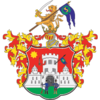Sombor
|
Sombor Град Сомбор |
||
|---|---|---|
| City and municipality | ||
| City of Sombor | ||

Sombor Town Hall
|
||
|
||
 Location of the municipality of Sombor within Serbia |
||
| Coordinates: 45°47′N 19°07′E / 45.783°N 19.117°ECoordinates: 45°47′N 19°07′E / 45.783°N 19.117°E | ||
| Country |
|
|
| Province | Vojvodina | |
| District | West Bačka | |
| City status | 17 February 1749 | |
| Settlements | 16 | |
| Government | ||
| • Mayor | Saša Todorović | |
| Area | ||
| • Municipality | 1,178 km2 (455 sq mi) | |
| Population (2011 census) | ||
| • Town | 48,000 | |
| • Municipality | 85,903 | |
| Time zone | CET (UTC+1) | |
| • Summer (DST) | CEST (UTC+2) | |
| Postal code | 25000 | |
| Area code | +381 25 | |
| Car plates | SO | |
| Website | www |
|
Sombor (Serbian: Сомбор / Sombor pronounced [sɔ̂mbɔr], Hungarian: Zombor, Rusyn: Zombor (Зомбор)) is a city and the administrative center of the West Bačka District in the autonomous province of Vojvodina, Serbia. The city has a total population of 47,623 (as of 2011[update]), while its administrative area (including neighboring villages) has 85,903 inhabitants.
In Serbian, the city is known as Sombor (Сомбор), in Hungarian and German as Zombor, in Croatian and Bunjevac as Sombor, in Rusyn as Zombor (Зомбор), and in Turkish as Sonbor.
The older Hungarian name for the city was Czoborszentmihály. The name originates from the Czobor family, who were the owners of this area in the 14th century (The family name came from the Slavic name Cibor). The Serbian name for the city (Sombor) also came from the family name Czobor, and was first recorded in 1543, although the city was mentioned in historical documents under several more names, such as Samobor, Sambor, Sambir, Sonbor, Sanbur, Zibor, and Zombar.
An unofficial Serbian name used for the city is Ravangrad (Раванград), which means "flat town" in English.
The first historical record about the city is from 1340. The city was administered by the Kingdom of Hungary until the 16th century, when it became part of the Ottoman Empire. During the establishment of Ottoman authority, local Hungarian population left from this region. During the Ottoman administration, the city was populated mostly by ethnic Serbs. It was called "Sonbor" during Ottoman administration and was a kaza centre in Sanjak of Segedin at first in Budin Province till 1596, and then in Eğri Province between 1596 and 1687.
...
Wikipedia

